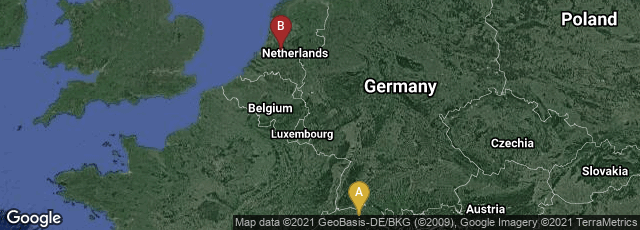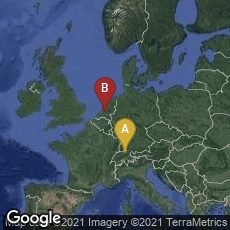

A: Kreis 1, Zürich, Zürich, Switzerland, B: Binnenstad, Utrecht, Utrecht, Netherlands
Fig.1 from "The Chemical Structure of a Molecule Resolved by Atomic Force Microscopy."
"STM and AFM imaging of pentacene on Cu(111). (A) Ball-and-stick model of the pentacene molecule. (B) Constant-current STM and (C and D) constant-height AFM images of pentacene acquired with a CO-modified tip. Imaging parameters are as follows: (B) set point I = 110 pA, V = 170mV; (C) tip height z = –0.1 Å [with respect to the STM set point above Cu(111)], oscillation amplitude A = 0.2 Å; and (D) z = 0.0Å, A = 0.8 Å. The asymmetry in the molecular imaging in (D) (showing a “shadow” only on the left side of the molecules) is probably caused by asymmetric adsorption geometry of the CO molecule at the tip apex."
On August 28, 2009 IBM Research – Zurich scientists Leo Gross, Fabian Mohn, Nikolaj Moll and Gerhard Meyer, in collaboration with Peter Liljeroth of Utrecht University, published "The Chemical Structure of a Molecule Resolved by Atomic Force Microscopy," Science, 2009; 325(5944): 1110 DOI: 10.1126/science.1176210
Using an atomic force microscope operated in an ultrahigh vacuum and at very low temperatures ( –268oC or – 451oF) the scientists imaged the chemical structure of individual pentacene molecules. For the first time ever, they were able to look through the electron cloud and see the atomic backbone of an individual molecule.
The abstract of the article is:
"Resolving individual atoms has always been the ultimate goal of surface microscopy. The scanning tunneling microscope images atomic-scale features on surfaces, but resolving single atoms within an adsorbed molecule remains a great challenge because the tunneling current is primarily sensitive to the local electron density of states close to the Fermi level. We demonstrate imaging of molecules with unprecedented atomic resolution by probing the short-range chemical forces with use of noncontact atomic force microscopy. The key step is functionalizing the microscope’s tip apex with suitable, atomically well-defined terminations, such as CO molecules. Our experimental findings are corroborated by ab initio density functional theory calculations. Comparison with theory shows that Pauli repulsion is the source of the atomic resolution, whereas van der Waals and electrostatic forces only add a diffuse attractive background."
♦ In December 2013 a video of the scientists discussing and explaining this discovery at IBM's Press Room was available at this link.